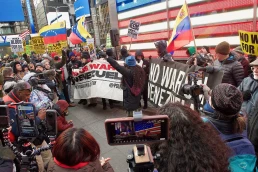The persistence of U.S. nuclear deterrence policy is an extortionist’s doctrine.
By Elaine Scarry, Boston Review
The key structure of the doctrine of nuclear deterrence is audible in the September 4, 2024 speech by U.S. Deputy Under Secretary of Defense Cara Abercrombie: “Any nuclear attack by the DPRK against the United States or its allies and partners is unacceptable and will result in the end of that regime.” The doctrine, which the United States has embraced since the Cold War, aims to prevent an adversary from launching a nuclear weapon by assuring that any first strike will be followed by a retaliatory second strike, whose effects will equal or exceed the original damage and may eliminate the adversary altogether. This annihilating reflex of deterrence is equally audible in the quiet words of the Department of Defense in its web page on “America’s Nuclear Triad,” its sea-based, land-based, and air-based delivery platforms: “The triad, along with assigned forces, provide 24/7 deterrence to prevent catastrophic actions from our adversaries and they stand ready, if necessary, to deliver a decisive response, anywhere, anytime.”

Framed wholly as defensive and preventative (and from day to day, largely successful in deflecting our attention from the actual first use stance the country has had for nearly eighty years), deterrence would almost have the aura of peacekeeping, were it not the mental platform undergirding our fourteen Ohio-class submarines (each able to singlehandedly destroy one of Earth’s seven continents), four hundred land-based ICBMs, and sixty-six B-52 and B-2 stealth bombers. Although the physical act of unbuilding the nuclear architecture is easily within reach—it would take at most four weeks to dismantle all the nuclear triggers throughout the world, a decisive because disabling first step—the mental architecture of deterrence is the major impediment to doing so.
One of the fiercest critics of nuclear deterrence is the former commander in chief of the U.S. Strategic Command, General Lee Butler. While serving in that role, Butler simultaneously served as Director of the Joint Strategic Target Planning Staff, overseeing the selection and coordination of twelve thousand nuclear targets. In the year the Berlin Wall fell, he became the director for strategic plans and policy in the Office of the Joint Chiefs of Staff. Butler could be crowing about the roles he had in overseeing the country’s nuclear deterrence in the twentieth century. Instead, from the deep interior of our country’s nuclear architecture, he has for decades denounced both the practice and theory of nuclear deterrence.
Recent Posts
Organized Labor Lambastes Trump’s Attack on Venezuela
January 11, 2026
Take Action Now Unions and international labor federations argue that it’s the same billionaires that want to run Venezuela who keep us working…
Schumer, Jeffries Refuse to Join Democrats’ Growing Calls to Slash ICE Spending
January 10, 2026
Take Action Now “I just don’t understand how we provide votes for a bill that funds the extent of the depravity,” said Sen. Chris Murphy.By Julia…
Billionaire’s Mouthpiece Searches For Reasons To Avoid Taxing Billionaires
January 9, 2026
Take Action Now California is considering a referendum on whether to impose a one-time wealth tax on the state’s billionaires.By Jim Naureckas,…
All Democratic Presidential Candidates In 2028 Should Commit To Dismantling ICE
January 8, 2026
Take Action Now Since its inception, ICE has been designed to conflate issues of immigration with terrorist threats against the U.S.By Sam…




